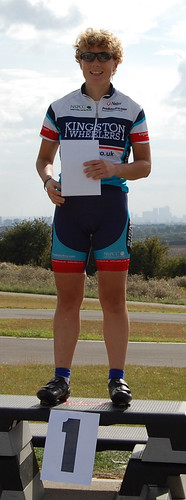With any climb comes a challenge, and the very nature of Boxhill with its easily identified start and finish points, unique switchbacks, low traffic and promise of cake at the end means amateur cyclists like myself can't resist racing themselves and the clock to get to the top. Thus the Boxhill Challenge was born, and it's one in which I fare pretty well compared to a standard TT or Richmond Park's 3LC (three lap challenge). Climbs level the playing field for smaller riders as long as their power is high relative to their weight. I'm not a pure climber by any means, but when the road goes up I don't mind at all! The longer the better, in fact.
 Boxhill Gradients
Boxhill GradientsBoxhill at 2.5kms with 5% average gradient means hitting it at full-on VO2max power, bouncing over the rough road, fighting an oft-present headwind, and forcing the pedals to keep turning over when it slightly steepens. It begins as you turn into Zigzag road, sheltered from the wind, and quickly progresses to the steepest section at about 10%, though you hardly notice it if you're carrying good speed after having sprinted to get a quick start!
Turning the corner into the next switchback usually means a tailwind, much welcomed albeit short-lived, and if you have a tailwind here, you're guaranteed to suffer a headwind on the third leg. That one parallels the first and is almost fully exposed to the elements. It's the longest leg and seems to go on forever, bringing about the inevitable bargaining and promises made with oneself: "just a few more minutes, you're almost there", "keep going, at the top you can stop", and my personal favourite "once this is over, you'll never have to do it again!"
Finally the last corner comes into view, inviting a sprint to get around it as the road starts to flatten. The last few hundred yards are a frantic dash to the "finish line", which is at the carpark entrance directly across from the cafe. Gasping for air, you hit "stop" on the bike computer and try to see through bleary eyes what time you did.
While I climb Boxhill as part of my rides around the Surrey Hills quite often, I only take part in the Boxhill Challenge once in a while. My brain does a pretty good job at remembering those bargains and promises I made to myself the previous attempt. Of course, those promises fade into lies, as I always find myself climbing Boxhill full-tilt not two months later, gasping and struggling and cursing the clock, the hill, the road, myself and all the other people who think it's important to race up Boxhill and test themselves, then post their results to motivate everyone else.
And my result? Yesterday's effort -- with a rare but favourable tailwind from the NW -- clocked 6:19 at 297 watts, more than 10 watts higher than my previous best and only one second off my best-ever time (set with my TT bike last September). In fact, I smashed my previous best road bike time by 14 seconds and set a new five-minute peak power record. And of course, I lied to myself that I'd never have to do it again, but in a month or two I'll be back again to see if I can break 300 watts and get closer to six minutes.
Boxhill Climb (297 watts):
Duration: 6:19
Work: 113 kJ
TSS: 16.6 (intensity factor 1.255)
Norm Power: 295
VI: 0.99
Pw:HR: 6.46%
Pa:HR: 0%
Distance: 2.487 km
Elevation Gain: 185 m
Elevation Loss: 60 m
Grade: 5.0 % (125 m)
Min Max Avg
Power: 133 479 297 watts
Heart Rate: 149 186 178 bpm
Cadence: 75 112 93 rpm
Speed: 13 35.5 23.6 kph
Altitude: 61 190 132 m
Crank Torque: 15.3 53.8 30.5 N-m

2 comments:
Hey - good climb. Just wondering how you get an elevation gain of 185 m and loss of 60 m when it's a constant incline (apart from the speed bumps!) Is that a quirk of the computer?
It's a software thing actually, WKO+ has a built-in elevation correction and it's notoriously oversensitive, calculating every little up and down. I generally use SportTracks to see what actual elevation gain and loss I've had on a ride, as WKO's numbers are usually twice as much!
Post a Comment